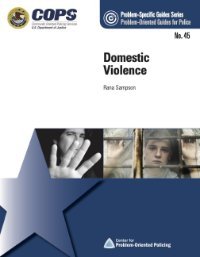This guide addresses serious youth gun violence, describing the problem and reviewing factors that increase the risks of it. It then identifies a series of questions that might help you analyze your local problem. Finally, it reviews responses to the problem, and what is known about them from evaluative research and police practice. Criminal misuse of guns kills or injures tens of thousands of Americans every year. In 2000, more than 10,000 Americans were killed with guns, and guns are much more likely to be used in homicides of teens and young adults than in homicides of people of other ages.
This guide begins by describing the problem of domestic violence and reviewing factors that increase its risks.† It then identifies a series of questions to help you analyze your local domestic violence problem. Finally, it reviews responses to the problem and what is known about these from evaluative research and police practice. Domestic disputes are some of the most common calls for police service. Many domestic disputes do not involve violence; this guide discusses those that do, as well as the measures that can be used to reduce them.
By John Klofas • Irshad Altheimer • Nicholas Petitti
This guide begins by describing the problem of retaliatory violent disputes and reviewing factors that increase the risks of such disputes. It then identifies a series of questions to help you analyze your local retaliatory violent disputes problem. Finally, it reviews responses to the problem from evaluative research and police practice. Although the guide draws heavily on the authors’ research and practice findings from the BJA/CNA Strategic Innovations in Policing-funded initiative in Rochester, New York—one of the few police initiatives explicitly focused on retaliatory violent disputes—the information in this guide is also supported by the broader body of research and practice on retaliatory violent disputes.
Read more at the Center for Problem Oriented Policing




